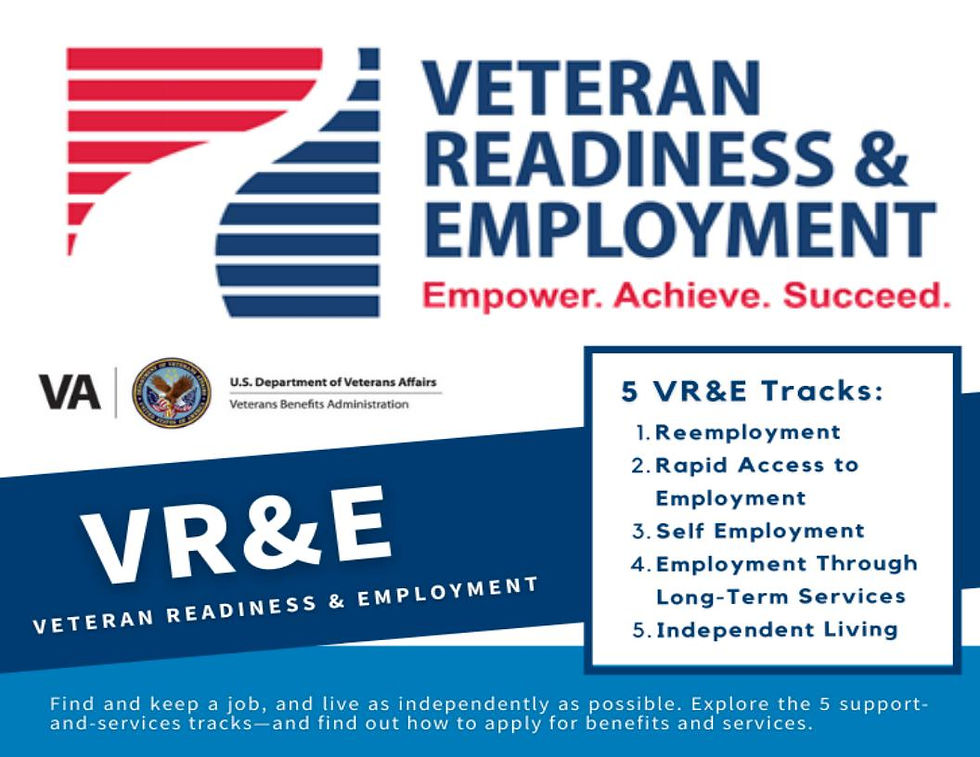For Disabled Veterans – A Successful Program Via Planned Gateways To Both Jobs And Education
- Ken Larson

- Aug 7, 2021
- 3 min read

“MILITARY TIMES“
“Officials from the Government Accountability Office said the Veteran Readiness and Employment program was used by about 123,000 veterans last year but has the potential to benefit even more.
VR&E participants work with an assigned vocational rehabilitation counselor, who helps the veteran identify a suitable employment goal and draft an employment plan, If participants opt to take classes, they can receive payouts on par with the post-9/11 GI Bill, and later switch to that program to complete degrees.”
________________________________________________________________________________
"Hundreds of thousands of veterans use their GI Bill benefits annually to earn a college degree, but thousands may be better served bypassing the well-known education program in favor of another Veterans Affairs program aimed at employment help for disabled veterans, according to a new report.
“Most school and [veterans service organization] officials we interviewed said veterans with disabilities often choose the GI Bill for education benefits because they are unaware that the VR&E program exists,” the report states.
“The officials attributed this lack of awareness to VA’s relatively limited promotion of VR&E and because of the prominence of the GI Bill as an education benefit program.”
The GI Bill education program dates back almost 80 years and is among the most well-known veterans benefits in the country. Under the Post-9/11 GI Bill benefits which went into effect in 2009, veterans or eligible dependents can receive full tuition payments at state universities, plus a monthly housing stipend and other financial assistance.
According to VA statistics, about 658,000 veterans used the benefit in 2020, at a cost of about $10.1 billion.
The VR&E program had about one-fifth the enrollment and about one-tenth the price tag of the GI Bill last year. To be eligible, veterans must be at least 10-percent disabled with a service-connected injury.
GAO officials said it may be more beneficial for many disabled veterans because of the flexibility of the program, and the focus not just on degree completion but also job training and independent living.
“Unlike the GI Bill, VR&E participants work with an assigned vocational rehabilitation counselor, who helps the veteran identify a suitable employment goal and draft an employment plan,” the report states.
“To develop the plan, the counselor and veteran review labor market information for jobs, taking into consideration the veteran’s identified abilities, aptitudes, and interests.”
That can include college classes, internships or apprenticeships. If participants opt to take classes, they can receive payouts on par with the post-9/11 GI Bill, and later switch to that program to complete degrees under certain circumstances. Under current rules, individuals who use GI Bill benefits first cannot switch back to the VR&E program.
Veterans groups have lauded the VR&E in Capitol Hill testimony in recent years, and lobbied for lawmakers to expand funding and resources for the efforts.
Researchers noted that not everyone who uses the GI Bill is eligible for the VR&E program, and that close work with a counselor or a focus on a specific job field may make the vocational rehabilitation program less attractive than the open-ended GI Bill for others.
But the GAO findings say that thousands of veterans may prefer it, if they are made more aware of the program. They say that department officials should do a better job explaining the differences and benefits of both the GI Bill program and VR&E program to eligible veterans.
“[More communication] would help better position veterans with disabilities to take the greatest advantage of the benefits these programs can offer,” the report states.
VA officials said they are working on that. In a statement to GAO, department Chief of Staff Tanya Bradsher said staff are already revamping materials on the two programs with an eye towards better promoting the VR&E benefits. New online information pages and print handouts on the program are due this fall.
The department’s current fact sheets and eligibility guidelines are available through the Veterans Benefits“




Comments